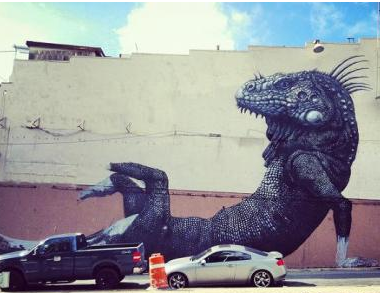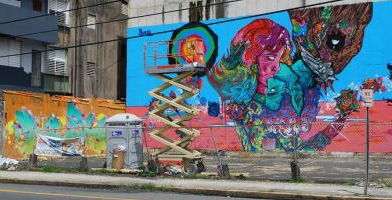Looking at the powerful new works from the San Juan Street Art Festival tells the tale that the world is in a Renaissance of creativity. Everywhere you turn, entire districts of new artwork are being created in urban centers across the earth. Seeing the works in San Juan, Miami, Valparaiso, Barcelona, Auckland, Toronto and Bologna shows that power that murals can have to help define and redefine community. Politicians and city officials with intelligence have recognized the power of artwork to build community, attract investment, and make our communities safer and healthier. Contrast them to backwards policies of places like Duncan, Canada that prevent new works from being produced or destroy free contributions to the community. The cities that have accepted and promoted murals early on have a huge step ahead of the cities that are barely catching on.
Sego painted a coqui. That makes sense because the soft-spoken Mexican mural artist dabbles luminously in the animal kingdom, improbably creating detailed scenes of magical realism with little more than aerosol cans.
The coqui is Puerto Rico’s mascot, the tranquil frog that defines the nighttime soundscape, and plagues tourists unused to the noise with its chirps. Sego’s wall, part of the first street art festival in San Juan history Los Muros Hablan, was an “aww” moment for the passing cars (and there are a lot of them. Sweltering San Juan lives and dies by the air-conditioned automobile.)

Less than a mile away, Roa is working on an iguana that, despite its vampy, lounging posture, holds a dead coqui in one languid claw. Roa is Belgium, and generally acknowledged to have popularized animal drawings in this brave new world of gallery-approved street artists. Delayed by the theft of his lift’s batteries and a few dehabilitating hangovers, he’s probably still working on the piece in San Juan’s 90 degree humid swampiness.
He left the frog death and pertaining iguana paw for the end of the piece. While I lounged in the shade of an orange road safety buoy last week, I watched cars stop, belching young men whose only desire was to take a picture with Roa. All the better if he was holding his baseball cap over his face (he always is.) Later these images would pop up on Instagram, appropriately hashtagged so that we could review them easily.
I wonder how San Juan will like the crushed coqui. “You can see a lot of things in it,” Roa told me on a late-night ride out to said jungle with some other Los Muros artists and attaches. The long-ago Spanish rule of Puerto Rico, the right-now United States colonization of the island. “There’s a lot of ways to interpret it,” he told me.
Though one will note a preponderance of animal renderings in the Los Muros Hablan renderings, it wasn’t all frogs and frog-killers in the Santurce streets. Local legendSofia Maldonado threw up a warning about the 709 women who have been murdered in Puerto Rico between 2000 and 2011. Though Maldonado was the only female muralist at the fest, La Repuesta — the spectacular, grungy club that gave over a back room to serve as Los Muros’ nerve center and gathering spot for the Escuela Central de Artes Visuales (Center High for the Visual Arts) students that assisted, and generally mooned around the artists in the festival — did host a Los Muros ladies night, featuring an all-female cast of live painters and DJs. Women made up the bulk of the audience at an artist panel discussion at San Juan’s Museo de Arte Contemporáneo (Museum of Contemporary Art), looked up at the scenes being sprayed on their city’s walls.
Argentina’s Jaz labored over a mural so layered it came off looking like an illustration from an Illuminati-made children’s book.
Mexico’s Nuezz painted a folkloric, horizontal man in a hat along the side of La Respuesta.
Ever from Buenos Aires is working (again, altitude delays) on a six-story naked woman shooting colorful shapes from her eyes who may or may not bear a resemblance to your humble writer, whose labia may or may have been seen by a substancial segment of San Juan commuters.
Spain’s Aryz (you’ll remember him from that Aesop Rock album cover) gave birth to a mermaid-toned skeleton man on a condo building.
Juan Fernandez, one half of the La Pandilla duo that along with mosaic artist Celso helped to organize the entire affair, drew endless loops that eventually formed a song bird. Alexis Diaz, the other half, had barely gotten started by the time I left Puerto Rico, so busy was he shuttling fellow artists from hotel to breakfast to wall and replacing stolen lift batteries. I’m sure whatever he’s working on will turn out great though.
Painting big murals is not, for most of even its stars, a money-making proposition. Los Muros Hablan paid its visiting artists airfare to the island, kitted them out with supplies, and occasionally-late lifts to access the dizzying heights of their canvases in exchange for their services in bringing attention to the often-overlooked Santurce neighborhood.
Santurce’s blocks, though they stand a 10-minute bike ride from the city’s white sand Ocean Park, are largely vacant by night. Flashy new condo developments dot the area, betting that new inhabitants will warm to a walkable ‘hood. One wonders how they feel about dead coquis.
In the case of its international visitors, the fest took charge of feeding the beasts, a source of consternation among the local painters. Making murals like these is generally just a way to make one’s impression on the streets, and of course the many bajillions of street art fans addicted to RSS feeds around the world.
Generally at these festivals, the artists wear their painted-ass shorts and sneakers 24 hours a day, and sleep three to a room until they’re off on the next flight — to Australia, to New York, back to Barcelona. They get paid in new tans and Instagram followers, aim for the interest of art collectors. Such is street life, even if you’re in charge of scenery.
Check next week’s paper for the debut of my new column Street Seen, featuring my interview of all-around Puerto Rican badass — and only female muralist at Los Muros Hablan — Sofia Maldonado

